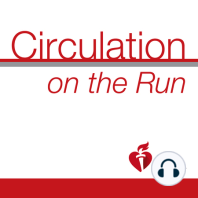17 min listen
Circulation September 20, 2022 Issue
ratings:
Length:
29 minutes
Released:
Sep 19, 2022
Format:
Podcast episode
Description
This week, please join author Jonathan Sterne and Associate Editor Shinya Goto as they discuss the article "Association of COVID-19 With Major Arterial and Venous Thrombotic Diseases: A Population-Wide Cohort Study of 48 Million Adults in England and Wales." Dr. Carolyn Lam: Welcome to Circulation on the Run, your weekly podcast summary and backstage pass to the Journal and its editors. We're your co-hosts. I'm Dr. Carolyn Lam, associate editor from the National Heart Center and Duke National University of Singapore. Dr. Greg Hundley: And I'm Dr. Greg Hundley, associate editor, director of the Pauley Heart Center at VCU Health in Richmond, Virginia. Dr. Carolyn Lam: Oh, Greg, we've got a special treat for everyone today. We have a third co-host and he is none other than Peder Myhre from Norway! Really adding to the diversity of our podcast: me from Asia, you from the US, and Peder from Europe. Welcome, Peder. Dr. Peder Myhre: Thank you so much, Carolyn. It's truly an honor to be here and I'm looking forward to being part of this podcast today. Dr. Carolyn Lam: Awesome. Well, here we go. Looks like we have a feature paper, Greg? Dr. Greg Hundley: Absolutely, Carolyn. Peder, welcome. So, listeners, our feature today will involve COVID-19 and its association with arterial and venous thrombotic diseases. But before we get to that, we're going to all grab a cup of coffee from all over the world and get into some of the other articles in the issue. Peder, Carolyn, how about I go first? My first study involves a prospective cohort of 94,000 individuals from the UK Biobank, who had device-measured physical activity from 2013 to 2015 and were free from myocardial infarction and heart failure. Now, Peder and Carolyn, the study was performed because although objectively measured physical activity has been found associated with acute cardiovascular outcomes, it has not been found associated with heart failure and, of course, a syndrome that's been expanding worldwide. As such this study led by Carlos Celis-Morales from the University of Glasgow aimed to investigate the dose response relationship between device-measured physical activity and heart failure by intensity of the physical activity. Now physical activity was measured with a wrist-worn accelerometer and time spent on light, moderate, and vigorous intensity physical activity was extracted. Incidental heart failure was ascertained from linked hospital and death records. Dr. Peder Myhre: Wow, Greg. That sounds amazing. Tell us, what did they find? Dr. Greg Hundley: You bet, Peder! These investigators found that, compared with participants who undertook no moderate to vigorous intensity physical activity, those who performed 150 to 300 minutes per week of moderate intensity physical activity or 75 to 150 minutes per week of vigorous intensity physical activity were at lower risk of heart failure. Now, interestingly, the association between vigorous intensity physical activity and heart failure was a reverse J-shaped curve with a potentially lower risk reduction above 150 minutes per week. And so, the take-home message for this first paper is that device-measured physical activity, especially moderate intensity physical activity, was associated with a lower risk of heart failure. Probably current vigorous intensity physical activity recommendations should be encouraged, but not necessarily increased. In contrast, increasing moderate intensity physical activity may be beneficial, even among those meeting current recommendations. Dr. Peder Myhre: Wow, Greg. That was a great summary. And the second original research article today is about high density lipoproteins. As you know, raising HDL cholesterol levels to prevent cardiovascular disease remains a hot topic. HDL plays a key role in reverse cholesterol transport and may be cardioprotective and reduce infarct size in the setting of myocardial injury. Lecithin cholesterol acyl transferase, LCAT, is the rate limiting enzyme in the revers
Released:
Sep 19, 2022
Format:
Podcast episode
Titles in the series (100)
Circulation January 24, 2017 Issue: Circulation Weekly: Your Weekly Summary & Backstage Pass To The Journal by Circulation on the Run
